The Jennings Sisters’ Boiled Custard
Stir and chat. Chat and stir.
That is all you need to know to make a good batch of boiled custard. That and to completely disregard its name. If you bring boiled custard to a simmer, let alone a boil, you will have a lumpy scrambled mess on your hands.
 The term boiled custard is an old-fashioned one that refers to the cooking process, done entirely in a pot over the heat, to distinguish it from its cousin, the set custard, which is gently baked, preferably in a water bath, to acquire a firm yet delicate texture. Today, boiled custard is more often called “stirred custard,” referencing the constant stirring required to ensure a smooth texture, or “soft custard” or “custard sauce,” describing its pourable, saucelike texture. Crème anglaise is a supreme example of this style of custard. In the South, though, the old-fashioned term lingers as does a particularly Southern way of enjoying it: as a traditional holiday beverage. Call it drinking custard. During the holiday season, you can find store-bought jugs of boiled custard in the dairy section of grocery stores, sitting right next to the eggnog, in some Southern states, Tennessee and Kentucky for certain. Leave it to Americans to transform an Old World dessert sauce the into a “big gulp.”
The term boiled custard is an old-fashioned one that refers to the cooking process, done entirely in a pot over the heat, to distinguish it from its cousin, the set custard, which is gently baked, preferably in a water bath, to acquire a firm yet delicate texture. Today, boiled custard is more often called “stirred custard,” referencing the constant stirring required to ensure a smooth texture, or “soft custard” or “custard sauce,” describing its pourable, saucelike texture. Crème anglaise is a supreme example of this style of custard. In the South, though, the old-fashioned term lingers as does a particularly Southern way of enjoying it: as a traditional holiday beverage. Call it drinking custard. During the holiday season, you can find store-bought jugs of boiled custard in the dairy section of grocery stores, sitting right next to the eggnog, in some Southern states, Tennessee and Kentucky for certain. Leave it to Americans to transform an Old World dessert sauce the into a “big gulp.”
I know. It’s completely illogical to talk about southern boiled custard at the beginning of April, four months past its season, yet too early to capitalize on the strange Christmas in July phenomenon. But sometimes you need to run with what you’ve been handed, while the inspiration is still fresh.
At the end February, at a family gathering to celebrate my mother’s 80th birthday, my cousin Joseph, reminiscing about his grandmother’s cooking and holiday traditions, suddenly said, “Let’s make boiled custard!” Joseph, a Tennessean, was the sole family member there from my father’s side of the family—the Jennings side.
Joseph’s forty-six-year-old boyish enthusiasm is hard to resist, but I didn’t need much encouraging. If it doesn’t go by the name of Jell-O salad, I’m always interested in learning how to make an old family recipe. This one, however, I’d never heard of. My curiosity was immediately piqued.
“What is boiled custard,” I said.
“It’s custard. You drink it.
“You drink it?”
“Uh-huh, and it’s so good. We’ll need a gallon of milk, a dozen, eggs, sugar . . .”
“That much milk and eggs! How much are we going to make?”
“That’s the recipe. It’s not too much. Trust me.”
How could I have missed boiled custard? It’s because, I realize, I descend from one of two Jennings sisters who broke Southern ranks, the first in more than 300 years to do so. In the 1930s Josephine Jennings, her older sister Evelyn Blackburn, and Evelyn’s husband, Brownlow Blackburn, migrated to Akron, Ohio, in search of job opportunities, leaving the small town life of Smithville, Tennessee, behind them. They left. The other three Jennings sisters—Ruth (Joseph’s grandmother), Ann, and Helen—remained in Tennessee.
Josephine, my grandmother, eschewed outmoded ways. She worked on the line at the Goodyear plant (garnering herself a medal for working endless days, without a break, during the war years), married a northerner, an aspiring jazz musician, drove a Pontiac Catalina, and, when it became acceptable for women to wear slacks, she slipped them on. She enjoyed a Rolling Rock pony from time to time, but she did not enjoy boiled custard, and she did not make it.
The task of carrying on the southern tradition of boiled custard in the north fell to Evelyn, who excelled at making sweets—caramel cake, chess pie, custard-style ice cream, pecan balls, coconut cake. Evelyn worked as a secretary at Goodyear, drove a Dodge Dart, wore horn-rimmed glasses and hats to church on Sunday and dresses every day of the week. She doted on the rose bushes in her garden out back, behind her house at 716 Excelsior Avenue, and, on two generations of nieces and nephews, scolding them when necessary, but always half-heartedly. She would rather enjoy a coke float with us than discipline us. We called her simply “Auntie,” pronounced Ā-nē.
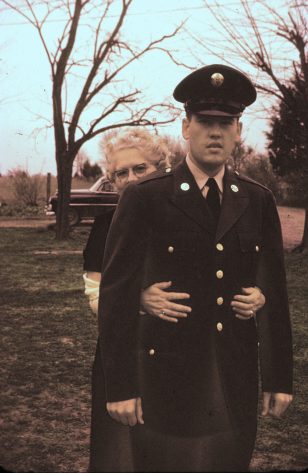
Evelyn (“Auntie”) with my father, Ray, during a visit to Aunt Ruth’s farm in Smithville, TN, ca. 1959
By the time I was of a remembering age, in the late sixties, the boiled custard days at Excelsior Avenue were over. Auntie’s husband, Brownlow, had died many years prior and most of Josephine’s children had moved away from Akron. Auntie no longer held large gatherings at her house at the holiday time.
With the help of my aunt, uncle, and mother, I have some idea of what the Christmas-time servings of boiled custard were like. Aunt Linda, Josephine’s youngest child, recalls Auntie making a big batch of boiled custard, always in the same gray pot, and setting the pot outside in the snow to cool. When Linda was old enough she would help to stir the custard (a good use for child labor), and when she was even bigger, Linda had the privilege of carrying the steaming pot of custard outside herself. Once it was chilled, Auntie served it in small dried-beef-jars-cum-drinking-glasses with a small spoon. Linda recalls enjoying Auntie’s boiled custard, and remembers it as being mostly smooth, most of the time. Uncle Carl, Josephine’s middle child, doesn’t have the same fond memory of those obligatory servings. He adored Auntie, but not her custard: “Mmm, Auntie’s boiled custard . . . those small bits of cooked egg were, uh, a little off-putting.” Like Carl, my mother distinctly remembers a little texture to the creamy custard, sort of like tapioca pudding. But that didn’t keep her from enjoying its delicious, sweet taste. My father, Josephine’s eldest, would have had Auntie’s custard, too, but he died when I was still a child, long before having any idea that I would one day like to ask him about it.

From left to right: My father, Ray, his sister Linda, and his brother Carl at Auntie’s house during the holiday season, ca., 1953.
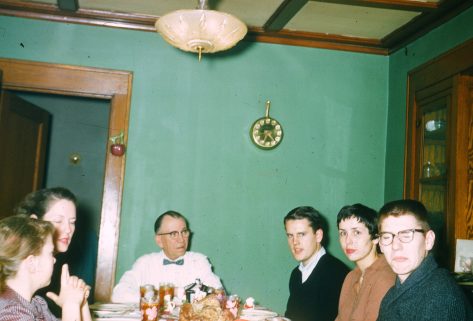
Family dinner at Auntie’s house on Excelsior Avenue, ca.
1959. (From left to right: My aunt Linda, my grandmother (Josephine), Brownlow Blackburn (Auntie’s husband), Ray and Louanne (my father and mother, before they were married), and my uncle Carl. Carl says this photo must have been taken just after he had some of Evelyn’s boiled custard.
(Footnote: I’m a fact checker by nature. To verify my relations’ recollections of Auntie’s boiled custard I went straight to the primary source(s), or tried to. I pulled out a Ouija board, set a pair of my grandmother’s earrings beside it, and asked her why she didn’t like boiled custard. When she didn’t respond, I changed the question to ask if the actual fact was that she didn’t like to make it because she’d had spent too many hours stirring boiled custard when growing up. I recall her vowing to never eat certain foods in her adult life that she had helped to prepare one to too many times during her childhood, often foods for the boarders at her mother’s boarding house. I tried to reach Auntie and my father as well, but unfortunately none of them responded.)
* * * * * * * * * * * * * * * * * * * * * * * * * * *
In his book Southern Food, John Egerton says that all boiled custards are essentially the same: some recipes may call for yolks instead of whole eggs, or a little more or less sugar or vanilla, and some may not include a touch of salt, though most do. Joseph’s recipe uses whole eggs. If you think boiled custard sounds old-fashioned, making it with whole eggs is even more old-fashioned. According to food historian Stephen Schmidt, in his posting on custard on the site Manuscript Cookbooks Survey, whole-egg custard is Anglo in origin and as such would have been the very earliest type of custard made in the colonies. It began to fall out of favor, he says, when French cooking began to gain in popularity in privileged Americans homes, sometime around the middle of the seventeenth century. The French traditionally use just the yolks when making custard.
Schmidt says that boiled custard made with egg yolks may have been an easy sell in part because boiled custard made with whole eggs is trickier to pull off, having a narrower temperature window in which to achieve perfectly thickened custard before it begins to curdle. Perhaps this explains why Auntie’s boiled custard wasn’t always smooth. The fix, of course, is to strain it, but I doubt Auntie’s batterie de cuisine included a fine-mesh sieve or cheese cloth.
I’m glad Joseph’s infectious enthusiasm for whole-egg custard was my introduction to it. If I’d come across Schmidt’s comment about whole-egg custard being extra challenging to make, I may not have attempted it in the first place. Knowing how delicious whole-egg boiled custard is that would have been a shame. In fact, if it’s consumed as a holiday beverage, or as soft custard by the spoonful, the whole-egg version is superior to the egg yolk version, being both lighter on the tongue and thicker at the same time.

Me, at my mother’s house during her birthday festivities, making a full gallon batch of boiled custard per my cousin’s recipe.
When Joseph burst out “Let’s make boiled custard!” what he really meant is that I would make boiled custard and he would oversee my progress as his dutiful apprentice. I didn’t mind. He was a thoughtful teacher. The first thing he did was to bring me a stool to sit on.
Joseph has memories of his grandmother sitting on a stool in her farmhouse kitchen continuously stirring custard, with him by her side, chatting, to pass the time. He doesn’t recall her ever straining it; the occasional small piece of cooked egg was just part of it. She made it just twice a year, for Thanksgiving and Christmas, and stored it in the fridge in large mason jars. Joseph said he would beg his grandmother to make two batches so there would be extra. I can see why he did. It is creamy and comforting and delicious and goes down oh so easy. Even if Joseph and his three siblings never snuck draughts of boiled custard from the fridge, which they did, a single gallon batch would have disappeared quickly.

My cousin Joseph demonstrating the proper thickness of boiled custard. It should be thick enough to stick to the top of your upper lip.
Whether sipped or spooned, my family seems to have served boiled custard straight up, unadorned. It is so good on its own—think vanilla ice cream in liquid form—it doesn’t need anything. But there are some serving options to consider.
John Egerton, in Southern Food, suggests topping it with whipped cream and serving it with an accompanying slice of coconut cake. I’d like to try that.
My hygienist, in her early sixties or thereabouts, grew up in southwest Virginia. I often pick her brain about Virginia cooking while she picks my teeth. Last time I was in for a cleaning, a few weeks ago, I asked her about boiled custard. She doesn’t make it, but her mother did every holiday. Her mother made the whole-egg type, chilled it, and served it in little glasses with spoons. But her favorite way to enjoy the custard was poured over a slice of her mother’s famous coconut cake. That was the tops. But they never topped it with whipped cream. “Oh no!” she said. “That would ruin it!”
Despite my hygienist’s admonition, I had to give it a try. Especially after coming across Gibson Jefferson McConnaughey suggestion, in her book of family recipes from the Haw Branch Planation called Two Centuries of Virginia Cooking, to stir a little sherry into a serving of custard and then top it with whipped cream.
That is my new favorite way of enjoying boiled custard, as a faux île flottante lightly flavored with amontillado or oloroso sherry. It’s worthy of entering anyone’s cannon of desserts, around the holidays or anytime of the year. Served with a shortbread-style nut cookie, like a pecan sandies or pecan ball, to accent the nutty taste of the sherry, nothing could be nicer. Except chatting away the time with family or friends while you endlessly stir the custard.
Jennings Family Boiled Custard Recipe
This is nearly identical to making custard for freezing into ice cream, except that it is less eggy and less rich, being made entirely with milk rather than with cream and with fewer eggs, relative to the overall volume. Another difference with this particular version of boiled custard is that it uses whole eggs rather than just the yolks, which makes the custard lighter on the tongue yet at the
same time luxuriously thick. Serve it chilled as a drink or as soft custard eaten by the spoonful, or use it as a dessert sauce for plain cake, gingerbread, poached fruit, fruit pie. To serve it as sherry-flavored faux île flottante, pour the custard into a dainty glass and stir in ¾ teaspoon of amontillado or oloroso sherry to each 3½ to 4-ounce quantity of custard and float with a spoonful of whipped cream, lightly sweetened and flavored with a little vanilla. This quantity of sherry may seem minuscule, but it’s just the right amount: you want to barely detect the sherry, to add an unpinpointable elegance to the custard. Add any more and you’ll overwhelm the subtle flavor of the boiled custard.
- 2 quarts whole milk
- ½ vanilla bean pod, about 4 inches long, or ¾ to 1½ teaspoons vanilla extract (see Note)
- 1 generous pinch of salt
- 6 large eggs
- 1 cup sugar
- Place the milk in a large heavy bottom. If using vanilla bean, slit it in half lengthwise with a paring knife, then take the tip of the knife and scrape the minuscule seeds from the pod into the milk. Drop the pods in to the milk, add the salt, and bring to a bare simmer over medium heat.
- Meanwhile, in a heatproof mixing bowl, beat the eggs well with a whisk, then add the sugar and whisk to combine.
- Whisking constantly, gradually add about half of the hot milk, ladleful by ladleful, to egg-sugar mixture to temper the eggs.
- While whisking, add the tempered egg-sugar mixture into the pot with the remaining milk.
- Set the pot over medium-low to low heat and gently cook, stirring constantly with a wooden spatula in a figure eight motion, until the custard is noticeably thickened. When sufficiently thickened, it will easily coat a spoon and will feel decidedly heavier as you pull the wooden spatula through it. Grab a stool to sit on and a friend to chat with to pass the time: It will take a good 1 hour and 15 minutes to thicken. Whatever you do, do not allow even a single bubble to break the surface. If you heat it beyond 180°F, you risk curdling it. If you’re a thermometer using type, 175°F is a good temperature to aim for. When stirring the pan, be sure to get the spoon into the bottom corners of the pan as that is where the egg will coagulate first.
- To make sure the custard is smooth, strain it through a fine-mesh strainer and set in a bowl over ice water. Add the vanilla extract, if using, to the custard Stir until cooled, then refrigerate to chill thoroughly before serving. It will thicken to a luxurious, almost milk shake–like consistency that it will easily coat the top of your upper lip. Keeps for 5 days. Makes 9 cups
Note: The Jennings sisters would have used vanilla extract, not vanilla pods, to make vanilla custard. I use a minimum amount of vanilla, less than what most boiled custard recipes call for. If you like a more pronounced vanilla flavor use a whole vanilla bean pods or at least 1 teaspoon of extract.
P.S. to Richmonders:
If you’d like to sample a range of sherries before committing to a bottle, and would like to do both of those things at the same place, head to Saison Restaurant and Market in Jackson Ward. Start out at the bar on the restaurant side. The night I was there Justin was behind the counter. He was extremely helpful, guiding me toward sherries that he thought would likely go best with boiled custard. Then walk over to the market side of Saison, one door down, to purchase a bottle (they offer at least five types and multiple brands). Note that not all the sherries available by the glass are sold on the restaurant and market sides of Saison. To taste them all, you will have go bar hopping, but at the same establishment (if this sounds confusing, all will be clear when you’re there.)
To find Guinness Irish Gingerbread, shown in the photo, look for Two and a Half Irish-Men at local Richmond farmer’s markets, where they offer their baked goods for sale, or visit their site.
P.S. (April 12, 2017) To get an excellent teeth cleaning, and get in some good food talk (or, more so, food questions, since you can’t say too much when a dental tool is inserted in your mouth), make an appointment with Jeanne Crigger at VCU School of Dentistry. She is my hygienist and a fellow food lover, and she said she didn’t mind that I mention her by name.

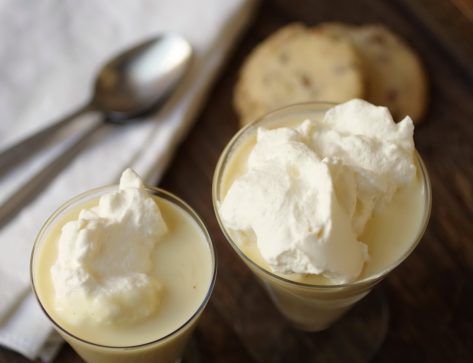

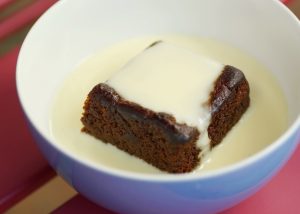
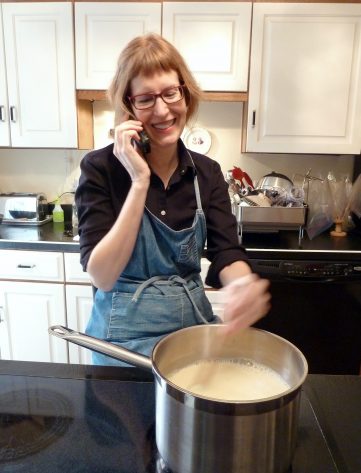
Love this story! (Gorgeous pictures of your parents, too.) My British friends used to make it to serve over Strawberry Rhubarb pie. They never served fruit pies with ice cream. I think they were right-the cold of the ice cream numbs the taste buds while the custard does not.
1Dearest Holly, This is certainly an all inclusive, interesting and charming story which leads to a yummy recipe. I know first hand, the glories of eating or drinking boiled custard. The variations you have included sound so inviting. Makes me want to pull out the stool and get busy. Your story telling is fabulous. Keep it coming! Your admirer, mom
2Thank you Becket. It was a great exercise in going down memory lane with family members, really enjoyable. The Brits know what they’re doing when it comes to desserts and custards and the like. I agree. Let’s take their lead and this strawberry season make some pie and some boiled custard and enjoy the two together.
3And you have a nice, padded stool to sit on at just the right height that works perfectly (which I know since I gave it a trial run . . . )
4I am honored to be mentioned in this charming post. Explaining boiled custard within a story about how your family served (and did not serve) it brings this old-fashioned, increasingly unfamiliar dessert to life–and, I hope, will encourage people to make it, for, as you write, it is wonderful! I am a Northerner and first learned about the southern custom of drinking boiled custard at holiday time about twenty-five years ago, from an Alabama woman named Marge Laser. She gave me her recipe, which I make nearly every Christmas. The people at my table are Northerners, so I announce it as “eggnog,” and everyone invariably proclaims it the best eggnog ever!
5Your research laid down an important theme for my story, so I am very thankful my online research brought me to your fascinating revelations about custard. How lucky your co-Northern friends and family are to be treated to a regional specialty every holiday season. I’ll have to do my part, too, and make it every holiday and invite folks over to enjoy it. Here in Richmond, even though I’m in the “Upper South,” I’ve run into a fair number of people, especially the younger generations, who don’t seem to be familiar with it. Marge Laser of Alabama would be very happy to know that you still make boiled custard very year, even if some of your guests call if eggnog.
6I would be honored if you use my name in your blog. I will most certainly share Momma’s
7Boiled Custard and Coconut cake recipes when I come across them. I will mention you have lovely teeth and a beautiful smile.
Jeanne, I’m glad you enjoyed being part of my story. You’re now immortalized in the oral history of boiled custard. Not bad. And I’ll take your praise of my teeth. That is something coming from you, my hygienist. If I ever get a cavity, I’ll have to blame it on perfectionist streak, of testing and retesting recipes. And you can’t just throw away those test batches, can you?
8Seems like I remember a lively conversation going on that evening along with a lot of use of arm muscles! Loved it!
9You hit the nail on the head–chatting and stirring. Thanks to you, Deonna, I learned that boiled custard is available in stores, right next to the egg nog, during the holidays. I don’t think it’s available here in Richmond in stores, but this holiday season I’m going to pay closer attention to see if it is, out of curiosity. But even if I find it here, I’ll still make it myself (from online research, I don’t like the look of the list of ingredients in the store-bought stuff).
10